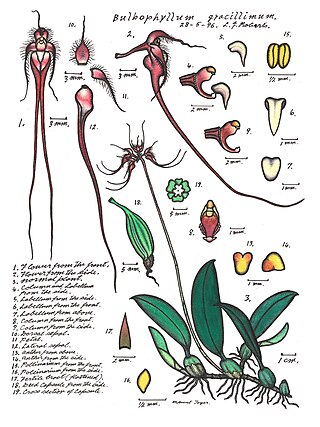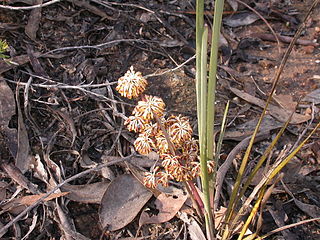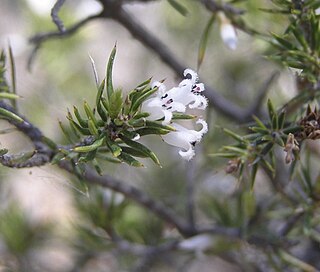
Hymenosporum is a monotypic genus of trees in the family Pittosporaceae. The sole included species is Hymenosporum flavum, commonly known as native frangipani, found in the rainforests and wet sclerophyll forests of New Guinea, Queensland and New South Wales. Despite its common name, it is not closely related to the frangipani, but is related to the widespread genus Pittosporum.

Verticordia brownii, commonly known as pink brownii or pink cauliflower is a flowering plant in the myrtle family, Myrtaceae, and is endemic to the south-west of Western Australia. It has small, neatly arranged, oval leaves and heads of pale pink to magenta or white flowers. It was one of the first verticordias to be collected, although it was not initially known by that name. The collection was made by Robert Brown on the Bass and Flinders circumnavigation of the Australian mainland on HMS Investigator.

Zanthoxylum brachyacanthum, known as thorny yellow-wood, satinwood, satin tree or scrub mulga, is a species of flowering plant in the family Rutaceae and is endemic to north-eastern Australia. It is a rainforest shrub or tree with thick, cone-shaped spines on the trunk and prickles on the branches, pinnate leaves, and male and female flowers arranged in panicles.

Gossia bidwillii, known as the python tree is a rainforest myrtle of eastern Australia. The usual habitat is the drier rainforest areas. The range of natural distribution is from the Hunter River in New South Wales to Coen in far northern Queensland.

Bulbophyllum bowkettiae, commonly known as the striped snake orchid, is a species of epiphytic or lithophytic orchid with thin, creeping rhizomes and flattened pseudobulbs each with a single tough, dark green leaf and a single cream-coloured flower with red stripes. It grows on trees and rocks in rainforest in tropical North Queensland, Australia.

Bulbophyllum gracillimum, commonly known as the wispy umbrella orchid, is a species of epiphytic orchid. It has a creeping rhizome, widely spaced, olive green pseudobulbs, each with a single thick, leathery, fleshy leaf and between six and ten purplish red flowers spreading in a semicircular umbel. The flowers have distinctive long, thread-like tails on the lateral sepals. It has a wide distribution and is found in New Guinea, New Caledonia, Indonesia, Malaysia and part of tropical North Queensland.

Blepharocarya involucrigera is a tree in the mango and cashew family Anacardiaceae. It is endemic to Queensland, Australia. Common names include north Queensland bollygum, northern bollygum and rose butternut.

Goniocheton arborescens, commonly known in Australia as Mossman mahogany, is a small tree in the mahogany family Meliaceae. It is native to rainforests of Malesia, Papuasia, Queensland and nearby islands.
Caladenia atroclavia, commonly known as the black-clubbed spider orchid, is a plant in the orchid family Orchidaceae and is endemic to south-eastern Queensland. It is a ground orchid with a single hairy leaf and a pale greenish-cream coloured flower with dark purple clubs and red patches on the petals.

Entada phaseoloides, commonly known in English as the matchbox bean or St. Thomas' bean, is a large twining vine or liana in the pea and bean family Fabaceae, native to a broad area of Asia-Pacific, from China to northern Australia and the southwestern Pacific.

Lomandra multiflora, also commonly known as many-flowered mat rush, mat rush and many flowered mat-lily, is a perennial, rhizomatous herb found in Australia and Papua New Guinea. The mat rush is distributed widely in the region and common within its preferred growing conditions. Its conservation status is considered not to be of concern and risk.
Leucospermum profugum, the Piketberg pincushion, is a species of evergreen shrub in the family Proteaceae. It is an endangered species, only known from three close locations in the Western Cape province of South Africa. It has hairless and leathery inverted lance-shaped to oblong leaves tipped with mostly three or four teeth and flattened egg-shaped flowerheads of 9–12 cm (3.5–4.7 in) in diameter, that consist of initially yellowish-orange flowers that later change to salmon pink. From the center of the flowers emerge almost straight styles that jointly give the impression of a pincushion. Flower heads can be found between late September and December.

Pimelea curviflora, also known as curved rice-flower, is a shrub in the family Thymelaeaceae and is endemic to Australia. It is a small, hairy shrub with greenish-yellow or red tubular flowers.

Wachendorfia thyrsiflora, the marsh butterfly lily, is a plant species of 0.6–2.5 m (2.0–8.2 ft) high when flowering, that has been assigned to the bloodroot family. It is a large to very large evergreen perennial plant with an underground rootstock with clusters of roots produced at the nodes. The rootstock has a distinctive red colour that results from so-called arylphenalenone pigments. The sturdy, entire and broadly sword-shaped leaves have laterally flattened and pleated leaf blades. The golden yellow flowers are set a dense cylindrical panicle on a tall firm stalk. Flowering occurs from spring until mid-summer.

Styphelia mitchellii is a species of flowering plant in the family Ericaceae family and is endemic to Queensland. It is a shrub with sharply-pointed, narrowly oblong leaves and white, tube-shaped flowers.

Diploglottis bernieana, commonly known as Bernie's tamarind or large leaf tamarind, is a plant in the maple and lychee family Sapindaceae. It was first described in 1987 by the Australian botanist Sally T. Reynolds and is found only the Wet Tropics region of northeastern Queensland, Australia.

Ferocactus mathssonii is a species of Ferocactus found in Mexico.

Eurychorda is a monotypic genus of flowering plants in the family Restionaceae formally described in 1998. The only known species, Eurychorda complanata, commonly known as the flat cord-rush, is endemic to Australia. It is characterised by flattened stems and reduced, sheathing leaves.

Mackinlaya confusa is a plant in the carrot, fennel and parsley family Apiaceae that is endemic to Queensland, Australia. It was first described in 1909.

Debregeasia australis, commonly known as china grass or native ramie, is a plant in the nettle family Urticaceae endemic to Queensland, Australia.


















